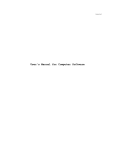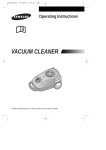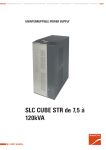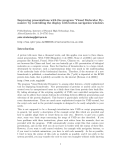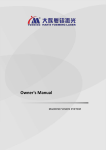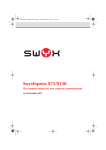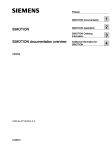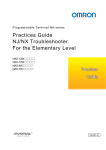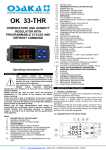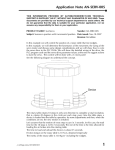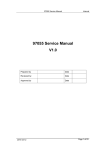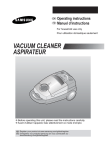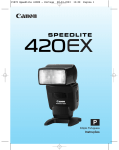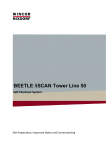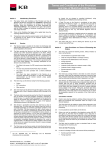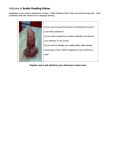Download TC41 EN complete instruction 02_2013
Transcript
Measuring and regulating technique Regulating and displaying unit TC -41 Complete instruction MRK s.r.o. Mierové námestie 30/24 Nová Dubnica 018 51 tel./fax. +421 42 44 31 345 www.mrk.eu [email protected] -2- -2- TC - 41 Complete instruction TC - 41 Complete instruction -3- Contents Regulating and displaying unit ................................................................. 1 Contents ................................................................................................... 3 Introduction .............................................................................................. 4 1. Description and function............................................................... 5 2. Mechanical installation ................................................................. 6 3. Connection ................................................................................... 7 4. Controlling .................................................................................... 7 5. Putting into practice ..................................................................... 9 6. Launching and stopping the process of regulation ....................... 9 7. Changing the set value - SEtP ................................................... 10 8. Ramp function - rAmP ................................................................ 10 9. HoLd function - HoLd, HdiF........................................................ 10 10. Setting communication with the PC – SerL, bAud, SAdr, Scnt... 11 11. Configuration of the regulation output – PID1, 2, 3 .................... 12 12. Type of the input probe .............................................................. 14 13. Number of the input probes........................................................ 14 14. Shifting the measured value – CAL1, CAL2 ............................... 15 15. Setting the cold temperature – rEF1, rEF2................................. 15 16. Displaying decimal places - dcPt ............................................... 15 17. Maximum rate of input reactions - OPEr .................................... 15 18. Blocking the set values – SPLo, SPHi........................................ 16 19. Setting the access passwords – Acc1, Acc 2 ............................. 16 20. Set alarm – ALAb, AlrE .............................................................. 16 21. Complete list of parameters ....................................................... 17 22. Error reports ............................................................................... 18 23. Parameters set by the producer ................................................. 20 24. Warranty card ............................................................................ 22 25. Notes.......................................................................................... 25 -3- TC - 41 Complete instruction -4- Introduction Thank you for buying our product. For its faultless usage, read these instructions so that it works correctly to your complete satisfaction. TC – 41 is an intelligent microprocessor unit, enabling regulation of measured process values according to required parameters. It can be entirely adjusted to your demands, however, that requires detailed knowledge of its system. Every user will not apply all the available functions, that’s why this instruction consists of two parts - Quick user’s manual Complete instructions for the TC – 41 system Quick manual contains basic information about TC – 41, survey and setting of the most important parameters, simple launch, stopping of the regulating process. The complete instruction will introduce you all the TC – 41 functions, enabling setting of the regulation parameters, displays, possibilities of connecting inputs and outputs, technical parameters. Instructions were written for the usage of TC – 41 as a controller of temperature, stated principles and settings are applicable also for other possibilities of usage. Attention : The device may be installed and operated only by people who are acquainted with these instructions, safety rules, and is authorized for installation of electrical devices in accordance with valid legislation. We hope you’ll be fully content with our product. -4- TC - 41 Complete instruction 1. -5- Description and function TC-41 is a compact regulating and displaying unit, enabling regulation, or displaying measured values of process values from the connected input probes. The controlling unit of TC-41 is determined to measure and display 1 or 2 input signals. Output controlling signal can be binary, analog with the possibility of galvanic separation. TC-41 can be connected into larger regulating wholes (multizonal furnaces...) with the possibility of connection to the PC with a serial interface RS232, RS485, MODBUS, IrDA ( infrared communication ). Controllers of visualisation in systems CONTROL WEB, CONTROL PANEL are available. Concerning the time reactions of the regulated complex, cascade connection of the regulators is also possible. Both measured and required (set) value are showed on two LED displays ( height of the segments is 14mm – good visibility even from a larger distance ). On the front panel, there are also 4 keys that set and control the device. Input, output and supply clamps are placed on the back side of the unit. The electronics of the controller is placed in a plastic box in panel making with standard covering of IP40, or more . All parameters are protected by a password against an unauthorized change. Basic parameters are available in the user’s menu of 1st level ( password 1 ) and more detailed setting is enabled by the user’s menu of 2nd level ( password 2 ). -5- TC - 41 Complete instruction -6- 2. Mechanical installation The device was constructed for the fitting into a panel and is equipped with two holds with aretation. The procedure of the fitting is as follows: - - Cut an oblong opening {92 x 44 mm} into the panel, the width of the panel maximum 5 mm Insert the device into the opening and put the holds on both sides ( the head of the screw is heading back to the connector of the device ). Press back and that will fix the holds, then fasten the screws, which will fasten the whole device Connect all necessary conductors onto the connector and insert it into the back part of the controller That will be the end of installation. -6- TC - 41 Complete instruction 3. -7- Connection Turn on the device in accordance with an enclosed scheme ( at the end of the instructions). Use a tag stuck on the upper part of the device for an aid. Power supply, inputs and outputs are marked there. Attention : the device may be connected and put into service only by a person with an appropriate qualification § 22 , 718 / 2003 Z.z. 4. Controlling pic.1 There are 4 keys for controlling : - browsing in displayed process values, increasing, lowering the value. - accesing menu Parameters 1, displaying error codes. - start of the programme, return to the basic status. The device displays three main offers Basic status, Parameters 1, Parameters 2, in which all the data can be set and viewed. To confirm the set value, push the key which will also take you to the following parameter. When you press shortly, you’ll also confirm the given value, and go back to the basic status. The return to the basic status will be realized also automatically after 30 seconds since you pressed the last key. The structure of the whole controlling menu is showed on the following picture number 2. -7- -8- -8- TC - 41 Complete instruction TC - 41 Complete instruction -9- pic.2 Transition to menu Parameters 1 : key for 3 seconds, provide the From the basic status: press the access password 1 ( default = 1 ) and confirm . Transition to menu Parameters 2 : On the menu Parameters 1, provide the access password 2 on the item PAS2 ( default = 2 ) and confirm with . There is also a quicker way to get from the basic status directly to the menu Parameters 2. Press at the same time and let go. The device will go on both keys straight to PAS2 part, where you have to provide the access password 2 and confirm . Menu Parameters 2 contains more levels. The names of individual levels are standardly showed on the red display, the green display shows inscription no or YES . These inscriptions show whether to enter the appropriate level or not. If there is for example the no inscription in the SErL part, the device will go on to the next part out1, after you press the key. If there’s YES, after pressing it enters the level SErL, and displays the first parameter, in our case it’s bAud. 5. Putting into practice After you turn on the device, the version number will be shown for a moment, and followingly it will go on to the basic status. The upper red display will show measured value, the lower green one will show the set value. The red display cyclically shows the value of the 1.input ( the number is displayed ) and the 2. input ( it flickers – if it is being used ). If the device had been active before ( green or yellow signalizing LED is displayed), it continues with the programme in course. Otherwise it waits for launching and the outputs are turned off. 6. Launching and stopping the process of regulation key for a little longer {3 seconds}, you will starts When you hold the the process of regulation. It can be stopped in the same way. With standard settings, the controller tries to achieve the set value as fast as possible {green display}. When that happens, it will stay regulating on that value until you stop the regulation. -9- TC - 41 Complete instruction - 10 - 7. Changing the set value - SEtP Set the value with the keys in the Basic status. There is an option to set the device so that anyone could so easily change the set value. In this case, setting the set value moves to menu Parameters 1, where the input is via password. This function enables the manufacturer. When you hold the key for some longer time ( 3 sec ), it will take you to the user’s menu of setting the parameters. Accessing this menu is subject to awareness of the password. The password has been number 1 since production. With the key you‘ll set 1 on the green display and confirm with . The system will go on to the user’s menu and it will show the title of the first parameter SEtP – set value on the keys. Confirm and that red display. Set the value with the will bring you back to basic status. The lower green display now shows the required value which was set by you. Attention : after 30 seconds since the last push, the device itself will return to the basic status. 8. Ramp function - rAmP Technology often requires gradual growth of temperature so that the products are not destroyed. That’s why TC – 41 enables setting the maximum rate of increasement in temperature. Go through to the user’s menu ( in the same way as you did when setting the required value ). The key will take you to the following parameter rAmP, again with keys, set the rate of increasement within a minute. The oFF value is set standardly, that means: ramp turned off = maximum rate. 9. HoLd function - HoLd, HdiF HoLd serves for automatic ending of the programme ( turning off the outputs ) after a set time. In the user’s menu, go on to the HoLd parameter, where you set the required hold in terms of minutes. When the controller achieves the set value, it will starts counting down the time remaining until regulation is turned off, meanwhile it still keeps teh - 10 - TC - 41 Complete instruction - 11 - achieved status in required tolerance. The red display cyclically shows the inscription tEnd – time remaining till the end of the process, the green display shows time in terms of minutes. When the time is over, the device beeps and turns off the outputs. Standardly, the - - - value is set, which means infinite time, i.e. the device will be still keeping the achieved value until it is turned off manually with the key. Setting hold is related to the following parameter HdiF – difference for launching hold. In fact it determines the tolerance zone, when the counting down of the rate can be started. Example : SEtP = 300 ° C HoLd = 60 min HdiF = 10,0 ° C When turned on, the controller tries to reach 300 ° C. The temperature increases until it reaches 290 ° C ( en trance to the tolerance zone ), the device beeps and starts counting down the time remaining until the end of hold. But still it tries to reach 300 ° C and it will keep regulating on this value until the hold time is over. Then it ends the programme and turns off the outputs. 10. Setting communication with the PC , RS485 – SerL, bAud, SAdr, Scnt TC – 41 can contain serial interface for communication with a superior system, or even with other controllers TC – 41. Setting of the communication rates, addresses and other parameters is transferred in the menu Parameters 2, part SErL. According to the structure of the menu ( pic.number 2 ) go to the menu Parameters 2 to the item SErL ( see pg. 7 – transition to menu Parameters 2 ). Enter SErL and on the item bAud set the communication rate. Standardly. The value of 57.6 kBaud is set. Another item is SAdr – address of the device. Every device on the line has to have a unique address, while address 0 is a label of the superior ( MASTER ) device. Master has also following item Scnt which determines the number of the subordinate ( SLAVE ) devices. This item is not displayed if the controller has some other address than 0. What follows is Stou which is maximum time for answering the question from other devices on the line. If there is no answer within that time, TC – 41 reports error of the line. Used communication protocol – MODBUS. - 11 - - 12 - TC - 41 Complete instruction 11. Configuration of the regulation outputs – PID1, 2, 3 In a standard version, the device contains 3 outputs. Out 2 is usually relay, Out 1, Out 3 differ according to individual models of TC - 41. They are usually adapted for controlling the semiconductors, SSR, by means of analog signals etc. Type of used outputs is stated on the tag at the lower part of the device. Each output can be assigned to different input. The controller allows you to assign any of inputs (In1, In 2) to the any of output. This option performed the manufacturer. The standard is as follows: - The version with one input - all three outputs respond to In1 - The version with two inputs - Out 1 and Out 2 respond to the input signal # 1 (In 1). Out 3 responds to input # 2 (In 2). This can be different in accordance with requierements. The controller also allows each output manage its own PID parameters. These are marked on the menu PID1, PID2, PID3. Parameters can also be allocated to different outputs. The default setting is: - PID 1 controls the OUT 3 - terminals 8, 9 - PID 2 controls the OUT 2 - terminals 5, 6, 7 - PID 3 controls the OUT 1 - terminals 3, 4 Explaining in detail the control parameters is beyond the scope of this manual. The controller complies with the international standards of The International Association of Automation Standard (www.isa.org). This provides for setting up of the regulatory process parameters P, I, D, B. Briefly explain the importance of these and other parameters that are directly linked together. We’ll state only one example of setting for Out3, in the remaining two the parameters and their function is identical. According to the structure of the menu ( pic.no.2 ) go to menu Parameters 2, item PID1 ( see pg. 9 – Transition to the Parameters 2 ). Now there‘s PID1 on the red display and no on the green one. The system offers us a possibility to go on to setting individual parameters for Out 3. Therefore we choose YES ( or ) and confirm . - 12 - TC - 41 Complete instruction - 13 - What follows is the list of parameters in PID1 : • diF1 – difference of the turning on of the output ( ° C ) It is in fact a shift of the set value Example : required value is 300 °C, diF1 = 5.0 Out 1 will be turned on until the measured temperature reaches 305 °C. • PbA1 – width of the proportional band ( ° C ) In this band, the controller controls the output so that it reaches the required value. This „fine-tuning“ is realized by shortening, or prolonging the time of turning on the output, according to the magnitude of the aberrance between the required and the measured value and other parameters. Setting the parameter on the off value means that the output will behave as a two-status output. That means that the measured value is lower than the required value – still turned on, and the other way around. Example : Required temperature = 300 °C, PbA1 = 10 Out 3 will be turned on until the measured temperature reaches 290 °C, then it starts turning on and off systematically, until it reaches the required temperature. • Int1 – integrating time constant ( sec ) Determines the share of the integrating component of the controller. It is in terms of seconds. Thise parameter only makes sense if the PbA1 is set. i.e. PbA1 is not off. • dEr1 – derivational time constant ( sec ) determines the share of the derivational component of the controller. It is in terms of seconds. This parameter only makes sens if the PbA1 is set, i. e. PbA1 is not off. b1 – default = 1. Ratio regulation constants for the transition to the set value and maintaining the set value. • - 13 - TC - 41 Complete instruction - 14 - Note : setting the PID parameters is a complicated process which requires deeper knowledge of the question of regulation. The aim of this document is not to make a detailed description of the theory of regulators, we recommend to read appropriate expert literature, or visit http://www.mrk.eu/, where you’ll find simple method of determination of the PID constants. • • • SAn1 – sampling interval ( sec ) It’s a frequency of calculating the action interference for the PID regulator. It is about how often should the particular PID regulator calculate its interference and turn on/off the output accordingly. Lin1 – limit output. Limiting temperature setpoint for the output. In practice, this means that the controller to regulate the output never above this value even when the required value in the Basic state higher. HYS1 – hysteresis ( ° C ) – only when PbA1 = off It is the area around the required value, where the controller does not react to change of the regulated process value, so- called zone of insensitivity. Example : Required temperature = 300 °C, PbA1 = off , HYS1 = 10 Out 3 will be turned on until the measured temperature reaches 300 °C, that’s when it turns off, then turn s on again when the temperature goes below 290 °C. Values of the parameters, set by the producer for each output, as well as all the other parameters set by the producer, are stated in the back part of these instructions. 12. Type of the input probe Set by the producer, according to requirements. 13. Number of the input probes Set by the producer, according to requirements. - 14 - TC - 41 Complete instruction - 15 - 14. Shifting the measured value – CAL1, CAL2 TC – 41 enables to set „deception“ of the measured value. This function is usable especially in case of measuring temperatures when it’s impossible to place the probe where demanded. The difference of the temperatures between the required and actually measured place can be set in the items CAL1 and CAL2 for the first and second output. These items are in the menu Parameters 2, part inPS. i , keys . will set the required shift and confirm with 15. Setting the cold temperature – rEF1, rEF2 This function is used in case of measuring temperatures by a thermocouple probe. There is a difference between temperatures in the place of measurement and the place where the measuring device is placed, and it influences the exactness of measuring. This inaccuracy can be eliminated when you use thermocouple cables, or cold junction box. In case of using thermocouple cables ( of the same type as the temperature probe ), the cold temperature is automatically measured by TC – 41. When using thermocouple box, it is necessary to set the temperature of the cold junction box on TC – 41. It can be set in the items rEF1 and rEF2, for the first and the second input. These items are in the menu Parameters 2, part inPS. Keys , will set the temperature of the cold junction box, or you can set Aut for automatic . measuring ( decrease value to -1 ) and confirm with 16. Displaying decimal places - dcPt To display the measured value more precisely you can allow displaying of the decimal places. In the menu Parameters 2, part inpS, there is an item dcPt, which determines the number of the displayed decimal places. Choose the required number and confirm with . 17. Maximum rate of input reactions - OPEr According to the used outputs which are controled by the device, It is possible to set the maximum rate of switching, by which you can increase the quality of regulation. - 15 - - 16 - TC - 41 Complete instruction This setting is in the menu Parameters 2, part SYSt , item OPEr. Possible extent from 0,05 sec. – 10,0 sec. It is obvious that short times can be used only when the main output controls the semiconductor power device ( triac, thyristor.. ). When using mechanical power devices ( relay, contactor ) it’s necessary to set longer time . 18. Blocking the set values – SPLo, SPHi TC-41 makes it possible to define the extent in which the required value can move. Ii is about determining the limits which cannot be crossed, otherwise the device won’t let you to set the required value. This setting is in the menu Parameters 2, part SYSt , where are the items SPLo – minimum and SPHi – maximum. With , keys you can set the required limits and confirm with . 19. Setting the access passwords – Acc1, Acc 2 To access menu Parameters 1 and Parameters 2 you need to know the access passwords. These were set during production on the values PAS1 = 1 a PAS2 = 2 . To change these, go to menu Parameters 2, part SYSt, items Acc1 – password for access to menu Parameters 1 and Acc2 – passowrd for access to menu Parameters 2. With , keys set new passwords and confirm with . 20. Set alarm – ALAb, AlrE Additional function. It is used for switching the alarm relay ( OUT 2 ) in the case of exceeding defined values. • ALAb – absolute value alarm. Output is activated when measure value exceeding this value. In practice, used as emergency signaling of temperature. • ALrE – relative value of alarm. Output is activated when measure exceeding set value above this parameter. In practice, it is used to alert the operator if the measured temperature exceeds the tolerance ALrE. Note : This feature is fixed to OUT 2, so the parameters PID2 ignored. - 16 - TC - 41 Complete instruction - 17 - 21. Complete list of parameters Basic status : tn1 – measured value input 1 - tn2 – measured value input 2 - SEtP – required value - trEF – reference temperature, cold junction ( see pg.15 ) - SPin – controlling temperature, ramp function ( pg.10 ) - tEnd – time till the end of hold ( pg.11 ) Parameters 1 : - PAS1 – password of access to the part Parameters 1 - SEtP – required value ( pg.10 ) - rAnP – required rate - ramp ( pg.10 ) - HoLd – required hold ( pg.11 ) - HdiF – zone of tolerance for launching hold ( pg.11 ) - ALAb – absolute value alarm - ALrE – relative value alarm - PAS2 – password of access to the part Parameters 2 Parameters 2 : - SErL – menu of serial line ( pg.11 ) o bAud – transfer rate o SAdr – address of the device o Scnt – number of devices on the line o Stou –connection timeout - PID1 – menu of the third output configuration ( pg.12 ) o diF1 – difference of turning on of the output o PbA1 – proportional band o Int1 – integrating component o dEr1 – derivational component o b1 – ratio PID o SAn1 – sampling interval o Lin1 – limit output o HYS1 – hysteresis - PID2 – menu of the second output configuration ( pg.12 ) o diF2 – difference of the turning on of the output o PbA2 – proportional band o Int2 – integrating component o dEr2 – derivational component o b2 – ratio PID - 17 - TC - 41 Complete instruction - 18 - - - - o SAn2 – sampling interval o Lin2 – limit output o HYS2 – hysteresis PID3 – menu of the first output configuration ( pg.12 ) o diF3 – difference of the turning on of the output o PbA3 – proportional band o Int3 – integrating component o dEr3 – derivational component o b3 – ratio PID o SAn3 – sampling interval o Lin3 – limit output o HYS3 – hysteresis inPS – menu of inputs o CAL1 – shift of the measure value of input 1 (pg.14) o CAL2 –shift of the measure value of input 2 (pg.14) o rEF1 – cold temperature of input 1 ( pg.15 ) o rEF2 – cold temperature of input 2 ( pg.15 ) o dcPt – number of decimal spaces ( pg.15 ) SYSt – menu of system settings o OPEr – sampling time of outputs čas ( pg.15 ) o SPLo – minimum set value ( pg.16 ) o SPHi – maximum set value ( pg.16 ) o Acc1 – password of access to Parameters 1 ( pg.16 ) o Acc2 – password of access to Parameters 2 ( pg.16 ) o Acc3 – reserved for the producer Some of the parameters does not necessarily have to be displayed – it depends on the config. of the device and on the user’s setting. 22. Error reports When there’s an error on the TC-41, it beeps and the LED diode on the front panel flickers. Along with that, in the Basic status, part Erros, an error codes is displayed. Accordingly to the code you can identify the problem. This code is in form of a hexadecimal number. Example : if ErrC = 1 – probe 1 error if ErrC = 2 – probe 2 error if Errc = 3 – both probe 1 and probe 2 error The meanings of the codes, as well as way of removing them to solve the errrors are stated in the following chart. - 18 - TC - 41 Complete instruction Number X X X X 1 2 4 8 1 0 4 0 0 0 8 0 0 0 - 19 - Meaning + removing Probe 1 error ( connector pins 16,17 ) - check the fitting of the clamps, wires, status of the probe, mechanical damage, with thermocouple probes the right polarity of the probe + compensating cables, burnt probe etc. Probe 2 error ( connector pins 14,15 ) - same procedure as with the previous error Measuring the reference temperature – temperature inside the device is beyond the allowed tolerance– 50 ° C, or the temperature probe inside the device is bad - replace the device prístroj into a warmer/ colder environment - in case of overheating turn off the device, don’t turn on until it reaches the temperature of the environment - the probe inside is bad – error removed by the producer Calibration error - removed by the producer Rewriting parameters – because of EMI, supply errors, etc. Parameters could have been rewritten - check ALL parameters of the level 1 and levell 2, turn off. When you tur nit on again, the erro is removed. Communication error –slave does not respond - check whether the second device is turned on, the address of the second device has to be different than 0 ( 0 = master ), same communication rate of both devices, check the cables of serial line Slave erros – defect on the subordinate device - see what error it is according to the error codes on the appropriate device and remove the defect - 19 - TC - 41 Complete instruction - 20 - 23. Parameters set by the producer Level Param. 1 Param. 2 SErL out 1 out2 out3 - 20 - Name of the parameter SEtP rAnP HoLd HdiF * ALAb * ALrE * bAud SAdr Scnt * Stou diF1 PbA1 Int1 * dEr1 * b1 SAn1 Lin1 HYS1 * diF2 PbA2 Int2 * dEr2 * b2 SAn2 Lin2 HYS2 * diF3 PbA3 Int3 * dEr3 * b3 SAn3 Lin3 HYS3 * Producer User TC - 41 Complete instruction inPS SYSt CAL1 * CAL2 * rEF1 * rEF2 * dcPt OPEr SPLo SPHi Acc1 Acc2 Acc3 - 21 - Reserved for the producer - 21 - TC - 41 Complete instruction - 22 - 24. Warranty card Product : Temperature controller TC - 41 Type : TC- 41 Production number : Warranty period : 24 months since the date of distribution Date of distribution : Date of installation : Direct customer : Final customer : Probe : Output: Max.working temperature: °C Warranty conditions : The producer provides 24 months of guarantee for this product since the date of distribution, except the errors caused by a mechanical or electrical wear of the outputs. The guarantee does not apply to any defects caused by incorrect storing, transport, incorrect connecting, damage caused by outer influence( especially electrical voltage, unallowed temperature, chemicals, mechanical damage ), electrical or mechanical overloading of the inputs and outputs. Service : MRK s.r.o. Mierové námestie 30 / 24 018 51 Nová Dubnica tel. 00421 – 42 –443 1345 - 22 - rev.01/2013 TC - 41 Complete instruction - 23 - - 23 - - 24 - - 24 - TC - 41 Complete instruction TC - 41 Complete instruction - 25 - 25. Notes - 25 -

























